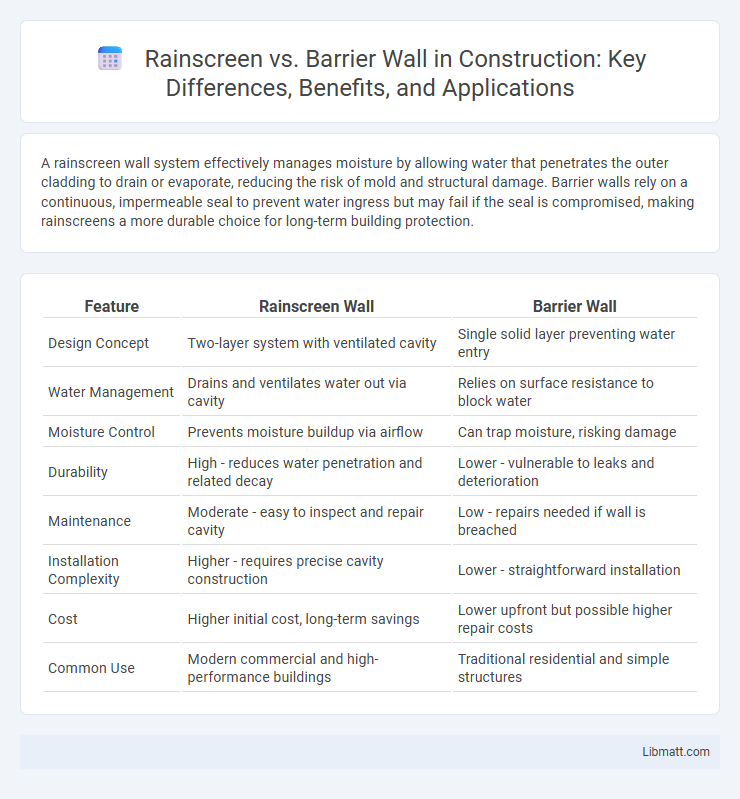A rainscreen wall system effectively manages moisture by allowing water that penetrates the outer cladding to drain or evaporate, reducing the risk of mold and structural damage. Barrier walls rely on a continuous, impermeable seal to prevent water ingress but may fail if the seal is compromised, making rainscreens a more durable choice for long-term building protection.
Table of Comparison
| Feature | Rainscreen Wall | Barrier Wall |
|---|---|---|
| Design Concept | Two-layer system with ventilated cavity | Single solid layer preventing water entry |
| Water Management | Drains and ventilates water out via cavity | Relies on surface resistance to block water |
| Moisture Control | Prevents moisture buildup via airflow | Can trap moisture, risking damage |
| Durability | High - reduces water penetration and related decay | Lower - vulnerable to leaks and deterioration |
| Maintenance | Moderate - easy to inspect and repair cavity | Low - repairs needed if wall is breached |
| Installation Complexity | Higher - requires precise cavity construction | Lower - straightforward installation |
| Cost | Higher initial cost, long-term savings | Lower upfront but possible higher repair costs |
| Common Use | Modern commercial and high-performance buildings | Traditional residential and simple structures |
Introduction to Rainscreen and Barrier Wall Systems
Rainscreen and barrier wall systems are two primary methods used in building envelope design to manage moisture and improve durability. Rainscreen systems incorporate an outer cladding layer with a ventilated cavity that allows for drainage and air circulation, effectively reducing water infiltration and material deterioration. Barrier walls rely on a continuous, impermeable surface to prevent water penetration, making your choice dependent on climate conditions and building requirements.
Key Differences Between Rainscreen and Barrier Wall
Rainscreen walls feature an outer cladding with a ventilated air cavity that allows moisture to drain and evaporate, preventing water infiltration and enhancing building durability. Barrier walls rely on a continuous, impermeable surface designed to block water penetration entirely, making them more susceptible to water damage if compromised. The key difference lies in moisture management, with rainscreens providing active drainage and drying, while barrier walls depend solely on their sealant integrity.
How Rainscreen Systems Work
Rainscreen systems function by creating a ventilated cavity between the cladding and the structural wall, allowing moisture to drain and evaporate effectively. This design reduces water penetration by using an outer layer that deflects rain, while the air gap promotes drying and pressure equalization, preventing water from reaching the interior. In contrast, barrier walls rely on a single watertight layer to prevent moisture ingress without the added ventilation benefits of a rainscreen.
Functionality of Barrier Wall Systems
Barrier wall systems function as a single-plane waterproofing barrier designed to resist water penetration and direct moisture away from the structure. They rely on the integrity of joints, sealants, and the wall assembly to prevent water ingress, typically requiring precise installation and regular maintenance. Unlike rainscreen systems, barrier walls do not provide a drainage cavity, making them less effective in managing moisture buildup within the wall assembly.
Advantages of Rainscreen Wall Assemblies
Rainscreen wall assemblies offer superior moisture management by allowing water to drain and evaporate through the ventilated air cavity, reducing the risk of mold and structural damage. These systems improve building durability and energy efficiency by preventing water intrusion and promoting effective drying. Enhanced thermal performance and prolonged facade lifespan make rainscreens a preferred choice over traditional barrier walls.
Benefits and Limitations of Barrier Walls
Barrier walls provide a solid, impermeable layer that effectively prevents water infiltration, making them suitable for less complex building designs and climates with moderate rainfall. Their benefits include simpler construction techniques and lower initial costs compared to rainscreen systems, though they can be prone to moisture accumulation and trapped water damage if not properly sealed or maintained. Understanding these limitations helps you decide if a barrier wall is appropriate for your project's durability and moisture management needs.
Typical Applications: Where Each System Excels
Rainscreen systems excel in high-moisture environments like commercial buildings, schools, and healthcare facilities where enhanced ventilation and moisture management are critical. Barrier walls are typically used in residential and low-rise buildings where simplicity and cost-effectiveness in construction are priorities, providing a solid waterproof layer without specialized drainage. Understanding where each system thrives helps you choose the best solution for durability and performance tailored to your building's climate and usage.
Moisture Management Strategies Compared
Rainscreen walls use an outer cladding with a ventilated air gap that promotes drainage and drying, effectively managing moisture by preventing water infiltration and allowing vapor to escape. Barrier walls rely on a continuous, impermeable layer to block water entry but may trap moisture inside, increasing the risk of mold and material degradation. When choosing your moisture management strategy, rainscreen systems often provide superior durability and indoor air quality by reducing moisture buildup and promoting building envelope breathability.
Cost and Maintenance Considerations
Rainscreen systems typically entail higher upfront costs due to their complex installation and material requirements but offer reduced long-term maintenance by effectively managing moisture and preventing mold or rot. Barrier walls present lower initial expenses but may incur increased maintenance costs over time due to potential moisture infiltration and the need for repairs or repainting. Evaluating budget constraints against expected maintenance frequency is crucial for informed decision-making between these two wall systems.
Choosing the Right Wall System for Your Project
Selecting the ideal wall system involves understanding the key differences between rainscreen and barrier wall designs. Rainscreen systems offer superior moisture management through ventilated air spaces that prevent water intrusion, making them suitable for projects in wet or variable climates. Your choice should reflect the building's exposure conditions, maintenance preferences, and budget, with rainscreens providing greater durability and energy efficiency compared to traditional barrier walls.
Rainscreen vs barrier wall Infographic

 libmatt.com
libmatt.com